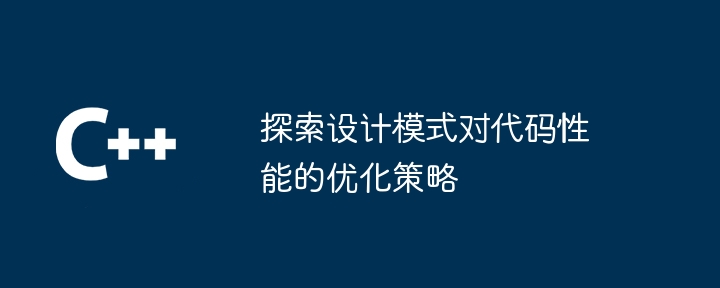
By applying design patterns, code performance can be optimized. Specific strategies include: Strategy pattern: allows dynamic exchange of algorithms to improve scalability and flexibility. Proxy pattern: Create a proxy object to control access to another object and optimize performance (such as delayed creation or caching). Factory pattern: Centralize control of object creation logic, simplify code and optimize performance.

Explore the optimization strategies of design patterns for code performance
Introduction
Design Patterns are successful and repeatedly used solutions in software development. By applying these patterns, developers can create maintainable, scalable, and efficient code. This article explores how design patterns can be used to optimize code performance.
Strategy Mode
Strategy mode allows algorithms to be swapped dynamically at runtime. This strategy isolates algorithms from the code that uses them, making the code more scalable and flexible.
// 定义策略接口 interface Strategy { int execute(int a, int b); } // 实现不同的策略 class SumStrategy implements Strategy { @Override public int execute(int a, int b) { return a + b; } } class ProductStrategy implements Strategy { @Override public int execute(int a, int b) { return a * b; } } // 客户端代码 class Context { private Strategy strategy; public void setStrategy(Strategy strategy) { this.strategy = strategy; } public int executeOperation(int a, int b) { return strategy.execute(a, b); } }
Practical case: Calculator
A calculator application can optimize code performance through strategy mode. Different strategies enable different mathematical operations such as addition, subtraction, multiplication and division. Client code can dynamically select policies as needed, improving application scalability and flexibility.
Proxy Pattern
Proxy pattern creates a proxy object to control access to another object. This proxy isolates object creation and use, allowing performance optimizations such as delaying object creation or caching access to objects.
// 定义代理类 class Proxy implements Subject { private RealSubject realSubject; public Proxy(RealSubject realSubject) { this.realSubject = realSubject; } @Override public void doSomething() { // 延迟对象的创建或对对象的访问进行缓存 if (realSubject == null) { realSubject = new RealSubject(); } realSubject.doSomething(); } }
Practical case: database access
Database access is often the bottleneck of performance in the code. Using the proxy pattern, we can create a proxy class to cache frequently accessed database query results. This significantly reduces the number of database accesses, thereby improving the performance of your code.
Factory Pattern
Factory pattern is responsible for creating objects. By using the factory pattern, developers can centrally control the logic of object creation, simplifying code and optimizing performance.
// 定义工厂类 class Factory { public static Product createProduct(String type) { switch (type) { case "A": return new ProductA(); case "B": return new ProductB(); default: throw new IllegalArgumentException("Invalid product type: " + type); } } }
Practical case: Object pool
Object pool is a design pattern that can reduce the cost of creating and destroying objects. The factory pattern can significantly improve performance by storing objects in a pool for later reuse.
Conclusion
Design patterns provide valuable strategies for optimizing code performance. By understanding and applying these patterns, developers can create scalable, flexible, and efficient code.
The above is the detailed content of Explore design patterns' optimization strategies for code performance. For more information, please follow other related articles on the PHP Chinese website!




